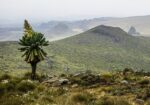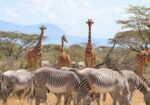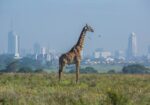Overview
Nestled in Kenya’s Central Highlands, the Aberdare Ranges form a striking mountain range stretching about 160 kilometers across Nyeri and Nyandarua counties. This range, part of the eastern escarpment of the Great Rift Valley, rises to elevations between 2,000 and 4,000 meters above sea level. The slopes often appear brown or grey depending on the interplay of sunlight and cloud cover, an effect that inspired the local Kikuyu people to name it Nyandarua, meaning “dry hide.”
The heart of these mountains is protected within Aberdare National Park, which spans 767 square kilometers and encompasses the central and higher elevations of the range. The park features a dramatic blend of alpine moorland, bamboo thickets, montane rainforests, winding rivers, and towering waterfalls. These diverse high-altitude habitats support a wide variety of mammals and a rich bird population, making the park a haven for nature lovers and wildlife enthusiasts.
However, the park’s cooler, misty climate and dense vegetation shape its wildlife behavior. Animals here tend to be more secretive, and sightings are less predictable than in the open savannahs of parks like the Masai Mara or Amboseli. This adds an element of mystery and reward to every wildlife encounter.
But the Aberdares hold more than just ecological importance. They are deeply woven into Kenya’s colonial and independence history. In the 19th century, white settlers arrived in the Central Highlands, forcibly displacing the Kikuyu from their ancestral lands to establish large agricultural estates. The region soon became the stronghold of colonial settlement, earning the name “White Highlands.” The injustices suffered by the Kikuyu under colonial rule eventually fueled the Mau Mau rebellion of the 1950s, and the Aberdare forests and valleys became a key base for Mau Mau fighters, playing a central role in Kenya’s struggle for independence.
Attractions and Unique Features of Aberdare National Park
Mammal Life
Aberdare National Park’s high-altitude ecosystems support an impressive variety of wildlife. Though lions are absent due to the dense forest cover, predators such as leopards, spotted hyenas, genets, and side-striped jackals are commonly found. In the open grasslands, visitors may encounter African buffalo, bushbuck, warthogs, and suni antelope. Forested areas and shrublands are home to forest elephants, black rhinos, red and bush duikers.
Rare and elusive species include the giant forest hog, bongo, golden cat, serval, African wild cat, African civet, and the blue duiker. The park is also rich in primates, including black-and-white colobus monkeys, Sykes (blue) monkeys, olive baboons, and vervet monkeys swinging through the treetops. Smaller mammals such as porcupines, tree hyraxes, and the nocturnal bushbaby (galago) also inhabit the area.
Reptiles are present but less commonly seen. These include the rare Gaboon viper, several chameleon species, and various small lizards and skinks.
Birdlife
With over 250 recorded species, Aberdare National Park is a paradise for birdwatchers. Common resident species include Hartlaub’s turaco, Jackson’s francolin, African green pigeon, cinnamon-chested bee-eater, montane white-eye, olive sunbird, Abyssinian crimsonwing, bronze-naped pigeon, tropical boubou, and the scarce swift.
Seasonal migrants from Europe and Asia add to the diversity, with species such as the European bee-eater, common buzzard, Eurasian hobby, willow warbler, white-throated robin, and barn swallow visiting during specific periods. Intra-African migrants like Klaas’s cuckoo and the red-chested cuckoo also frequent the park.
Rare and endemic birds found in the region include the Aberdare cisticola, Hunter’s cisticola, scarlet-tufted malachite sunbird, Sharpe’s longclaw, Kenya apalis, bar-tailed trogon, African green ibis, mountain yellow warbler, and the moorland chat.
Birds of prey include the crowned eagle, mountain buzzard, augur buzzard, African goshawk, and the migratory steppe eagle.
Scenic Landscapes
Aberdare National Park offers a stark contrast to the wide open plains found in many of Kenya’s other parks. Instead, it is set within the rugged Aberdare Mountain Ranges, with elevations ranging from 2,100 to 4,100 meters above sea level. The highest point is Ol Donyo Le Satima.
The range runs north to south and is shaped by dramatic ridges, steep valleys, and thickly forested slopes. Deep V-shaped valleys and river-cut gorges slice through the landscape, many lined with dense forest and concealing spectacular waterfalls. Rivers such as the Chania, Gura, Karuru, and Magura originate in the highlands and tumble down the escarpment in dramatic cascades. Karuru Falls, for example, plunges 273 meters in three tiers, making it the tallest waterfall in Kenya.
These rivers and wetlands sustain the park’s lush plant life and diverse wildlife. In the mid-elevation zones (2,200 to 2,800 meters), dense montane forests dominate, filled with camphor, cedar, podo, and fig trees. At higher elevations (2,800 to 3,200 meters), these forests give way to thick bamboo thickets that form nearly impenetrable corridors.
Above 3,000 meters, the landscape transitions to open moorland and heath, marked by giant heathers, tussock grasses, and strange, otherworldly plants like giant lobelias and groundsels. These high-altitude plains are often cloaked in fog and low clouds, creating a mystical and dramatic atmosphere.
The park also includes parts of the eastern escarpment of the Great Rift Valley. From the western slopes, visitors can enjoy breathtaking cliff-top views. On clear days, vistas stretch across the Laikipia Plateau, Mount Kenya, and even down to the floor of the Rift Valley.
Activities and Experiences in Aberdare National Park
Game Drives
Guided game drives are one of the most rewarding ways to explore Aberdare National Park’s rugged highland terrain. These drives take visitors through forests, bamboo thickets, and open moorlands to view wildlife uniquely adapted to high-altitude environments. Most drives are conducted in 4×4 safari vehicles equipped with pop-up roofs, providing wide, unobstructed views ideal for wildlife observation and photography.
Game drives are typically scheduled in the early morning and late afternoon, when animals are most active and easier to spot. During the hotter parts of the day, many animals retreat into the shade, becoming more elusive. For a different perspective, visitors can also participate in special night drives or enjoy floodlit game viewing at select lodges, offering the chance to see nocturnal animals in action. Full-day game drives are also available for those seeking a more immersive safari experience.
Birdwatching
Aberdare National Park is a paradise for bird enthusiasts, boasting over 250 recorded species. The park’s diverse habitats, ranging from montane forest and bamboo to moorland, support a wide array of birdlife, including highland forest specialists, endemics, and seasonal migrants. It’s an ideal destination for spotting rare and region-specific species.
Hiking and Guided Nature Walks
Guided nature walks and hikes offer a more intimate experience of the park’s dramatic landscapes. Visitors can trek through bamboo woodlands, misty valleys, rugged ridges, alpine moorlands, and rocky outcrops. Along the trails, there’s the chance to spot wildlife and highland birds up close.
One of the highlights is hiking to scenic waterfalls such as Karuru Falls, which plunges 273 meters in three distinct steps through the forest. Hikes vary in length and difficulty, ranging from short walks to full-day treks, and are led by experienced guides for safety and deeper insight into the environment.
Photography
Aberdare’s dramatic scenery offers incredible opportunities for nature and wildlife photography. From mist-covered moorlands and forested gorges to towering waterfalls and unique high-altitude flora and fauna, the park provides a striking contrast to the classic savannah backdrops of parks like the Maasai Mara. The diverse wildlife, rare bird species, and atmospheric landscapes make it a photographer’s dream.
Horseback Riding
Some lodges located on the slopes of the Aberdares offer horseback riding experiences. Riders can traverse open grasslands while enjoying panoramic views of Mount Kenya and the surrounding wilderness. Horseback safaris allow access to areas of the park that vehicles cannot reach, offering a quiet and unique way to observe wildlife.
Trout Fishing
For angling enthusiasts, the park offers peaceful trout fishing experiences in cold, clear alpine streams. With a permit, visitors can fish for brown and rainbow trout in rivers such as the Chania, Gura, and Magura. These rivers are ideal for fly fishing and provide a tranquil outdoor experience surrounded by natural beauty.
Camping and Picnics
The park offers a variety of scenic picnic spots, often located near rivers, waterfalls, or panoramic viewpoints. Both public and special campsites are available for those looking to immerse themselves in nature. Camping in the park provides an adventurous, up-close experience of Aberdare’s serene landscapes and nocturnal sounds.
Best Time to Visit Aberdare National Park
Aberdare National Park is a year-round destination, but its unique high-altitude rainforest ecosystem means it receives regular rainfall throughout the year. However, there are notable dry and wet seasons, each offering different experiences for visitors.
Dry Season (January–February and June–September)
These are the driest and most popular months to visit the park. Clear skies make for excellent scenic photography, and the thinner vegetation improves visibility for spotting wildlife and birds. Animals tend to gather around water sources during this period, increasing the chances of sightings.
Road conditions are generally better during the dry season, with fewer muddy or impassable sections. This is considered the high season, so expect larger crowds and higher accommodation prices.
Long Rains (March–May)
This period brings heavy rainfall, making many roads muddy, slippery, and sometimes impassable. Vegetation grows dense and tall, reducing visibility and making it harder to spot wildlife, which may disperse beyond park boundaries due to the abundance of food and water. Despite the challenges, this is the low season, so there are fewer visitors and more affordable accommodation rates.
Short Rains (October–December)
Rainfall during this time is usually lighter and more intermittent, often accompanied by mist. The park is lush and visually striking, and most safari activities remain accessible. This is considered a shoulder season, with moderate visitor numbers and pricing.
However, from mid-December through New Year’s, the park experiences a peak in tourist activity due to the holiday season, leading to higher accommodation rates.
Birdwatching Season (October–April)
This is the best time for bird enthusiasts, especially for spotting migratory species and rare highland forest and moorland birds. The rainy conditions may be a minor inconvenience for some, but they do not significantly hinder birdwatching activities.
Climate
Due to its high altitude, Aberdare National Park experiences cool to cold temperatures throughout the year, especially at night. Nighttime temperatures can drop below 10°C (50°F), even during the dry season. Visitors should come prepared with warm layers and waterproof clothing, as sudden rain showers are common and the weather can change quickly, even in the drier months.
Where to Stay in Aberdare National Park
Aberdare National Park offers a wide range of accommodation options to suit every budget and travel style, from rustic forest cabins and campsites to midrange country lodges and luxurious treetop retreats. Whether you’re a budget traveler, nature enthusiast, or luxury seeker, there’s something for everyone.
Budget Campsites and Cabins
Budget-friendly options include both public and private campsites located inside the park, often near moorlands or along trout-filled streams. These accommodations offer basic but charming facilities such as fireplaces, communal kitchens, and shared ablution blocks. They’re ideal for backpackers, adventure seekers, and nature lovers looking for a more immersive and affordable wilderness experience.
Midrange Lodges
Midrange accommodations are typically located just outside the park. These country-style lodges often feature expansive gardens, with some offering golf courses and sightings of resident wildlife. Facilities include comfortable cottages and suites, swimming pools, spas, and optional activities like horseback riding and golf. Restaurants serve buffet-style meals, offering good value without sacrificing quality or comfort.
Luxury Lodges
For those seeking a premium safari experience, luxurious lodges are available in strategic locations within the forest, often near salt licks or waterholes frequented by wildlife. These upscale lodges feature elevated viewing decks, observation lounges, and even underground bunkers for close-up animal viewing. Rooms are en suite, offering views of the forest or nearby waterholes. On-site restaurants serve a blend of local and international cuisine prepared by expert chefs, while bars offer premium drinks, cocktails, and fine wines. These lodges provide a perfect combination of comfort, exclusivity, and unforgettable wilderness luxury.
How to Get to Aberdare National Park
Aberdare National Park is located in Kenya’s Central Highlands, approximately 160 kilometers north of Nairobi. It is easily accessible by both road and air, making it a convenient destination for safari travelers.
By Road: The main entrance to the park is Mweiga Gate, located near Mweiga town along the Nyeri–Nyahururu road, about 17 kilometers from Nyeri town. The most common route from Nairobi is via the Nairobi–Thika–Nyeri highway, which passes through the scenic tea and coffee plantations of the Central Highlands. The road is fully tarmacked and well maintained, offering a smooth and comfortable drive.
By Air: Domestic airlines such as Air Kenya and Safarilink offer charter flights from Wilson Airport in Nairobi to Mweiga Airstrip, located in Mweiga town. The flight takes around 45 minutes and provides stunning aerial views of Kenya’s highland landscapes. Upon landing, pre-arranged safari vehicles are available to transfer you from the airstrip to your lodge or campsite. This option is ideal for travelers seeking speed, comfort, and a more exclusive safari experience.
Aberdare National Park Safari Packages
Aberdare National Park is an excellent choice for travelers seeking a serene and distinctive high-altitude safari experience. Safari packages range from exclusive stays within the Aberdares to multi-park itineraries that include destinations such as Meru National Park, Lake Naivasha, the Masai Mara, and even Kenya’s coastal beaches. These packages cater to both individuals and groups, offering flexible options to suit a variety of interests, durations, and budgets.
In contrast to the open savannahs of parks like the Masai Mara or Amboseli, Aberdare features a cool, misty climate, forested slopes, cascading waterfalls, and mountain streams. Whether you’re planning a short getaway or incorporating Aberdare into a longer safari circuit, it can be seamlessly integrated into a memorable and personalized itinerary.
Conclusion: Why Visit Aberdare National Park
Aberdare National Park offers a safari experience unlike any other in Kenya. Nestled high in the Central Highlands, it’s a place where misty forests, thundering waterfalls, and open moorlands come together to create a dramatic and peaceful landscape. Whether you’re spotting rare highland wildlife on a game drive, hiking through bamboo forests, fishing in mountain streams, or simply soaking in the views from a treetop lodge, Aberdare has a way of making you slow down and connect with nature on a deeper level.
It may not have the open plains or big herds of some of Kenya’s more famous parks, but that’s part of its charm. The cool climate, fewer crowds, and unique high-altitude ecosystem make it a perfect escape for nature lovers, photographers, birdwatchers, and anyone seeking something off the beaten path.
Whether you’re planning a weekend getaway or adding it to a longer safari itinerary, Aberdare National Park promises a refreshing, immersive, and unforgettable adventure in one of Kenya’s most enchanting landscapes.
Ready to Plan Your Aberdare Safari Adventure in Kenya?
At Giorgi Safaris, we specialize in tailor-made Kenya safari holidays crafted to match your interests, schedule, and travel style. Our packages include expert safari guides, reliable 4×4 vehicles with pop-up roofs for optimal game viewing, and thoughtfully designed itineraries that showcase the very best of each destination.
We partner with trusted lodges and camps to ensure your experience is smooth, enjoyable, and truly unforgettable from the moment you arrive to the moment you leave.
Contact Giorgi Safaris today to book your safari or request a custom itinerary tailored to your travel goals. We’re here to help you make the most of your time in one of Kenya’s most iconic and accessible wildlife destinations.









